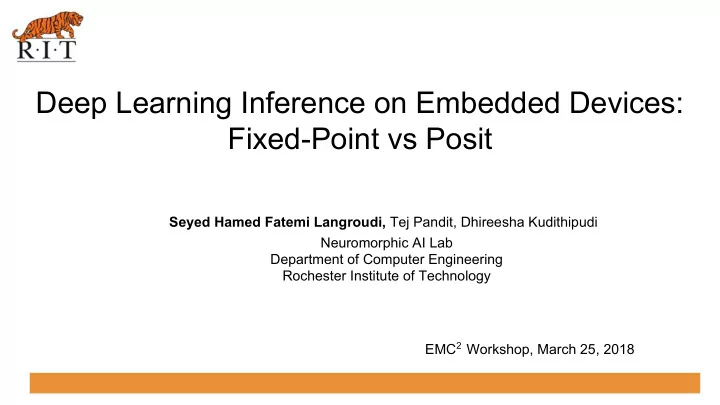

Deep Learning Inference on Embedded Devices: Fixed-Point vs Posit Seyed Hamed Fatemi Langroudi, Tej Pandit, Dhireesha Kudithipudi Neuromorphic AI Lab Department of Computer Engineering Rochester Institute of Technology EMC 2 Workshop, March 25, 2018 THE 1ST
Introduction Most digital neuromorphic chips are specialized for data centers Why Deep Learning Inference Drawbacks of performing Deep Learning inference in data centers: on Embedded Devices? Latency ❖ Accessibility ❖ ❖ Security 2 [3] [2] [1]
Introduction What are the challenges in designing/performing Deep ❖ real time performance Learning architectures for Energy consumption ❖ embedded devices ? Low precision Arithmetic ❖ Solutions for energy reduction ? Fixed-point number system ➢ 3.14159 26535 3.14 [4] [4] 3
Introduction Most previous work requires ❖ Current Approaches Quantization techniques ➢ Retraining ➢ Fixed-point number system represents numbers ❖ uniformly What is missing ? The parameters are distributed non-uniformly ❖ Using Posit Number System [5,6] ❖ ➢ Tapered number system [7] What is the solution ? (non-uniform distribution) ➢ ➢ More accurate than floating point 4
Posit Number System ❖ Proposed by John L. Gustafson, 2017 [5,6] n= number of bits Define : ❖ es= number of exponent bits [6] 5
Posit Number System Example: [6] 6
Posit Number System Conversion from Posit to real number Conversion from real number to Posit Sign ❖ ❖ = Divide or multiply by 2 → [1,useed) ❖ → Leading zero detection, exponent=Divide or multiply by 2 → [1,2) ❖ Leading one detection ❖ Fraction = rest of bits ❖ Exponent value Fraction value ❖ 7
Proposed Architecture 8
Experiments Task: ❖ Handwritten numeral classification, Image classification Parameters: ❖ Weights Number Systems : Single Precision Floating Point Number System ❖ Variable Length Fixed-point Number System ❖ Integer part = 1 bit ➢ Fraction part = [0,15] ➢ Normalized Posit Number System , p (i,0) where i = [2,8] ❖ Deep Neural Networks: LeNet-4 (2 Conv, 2 FC) , ConvNet (3 Conv, 2 FC) , AlexNet (5 Conv, 3 FC) ❖ Metric: Top-1 accuracy, memory utilization, memory access ❖ 9
Datasets MNIST Dataset [9] ❖ ➢ Categories = 10 [8] Inference = 10000 ➢ Cifar-10 Dataset [11] ❖ Categories = 10 ➢ [10] Inference = 10000 ➢ Subset of ImageNet [13] ❖ Categories =10 ➢ [12] Inference = 10000 ➢ 10
Baseline Results Single Precision Floating Point Number System: Task Dataset # inference set Network Layer Top-1 Accuracy Digit Classification MNIST 10000 Lenet 2 Conv and 2 FC 99.03% Image Classification CIFAR10 10000 Convnet 3 Conv and 2 FC 68.45% Image Classification ImageNet 10000 AlexNet 5 Conv and 3 FC 55.45% 11
Results for proposed architecture on different datasets MNIST CIFAR-10 ImageNet 12
Summary of Results Dataset Network # bits # bits (FIX) # bits ( NP ) Memory utilization ( FP) 1% accuracy 1% accuracy degradation degradation MNIST Lenet 32 7 5 28.6% CIFAR10 Convnet 32 11 7 36.4% ImageNet AlexNet 32 9 7 23% FP = Floating Point FIX = Fixed-point NP = Normalized posit ● It can also reduce the number of memory accesses through memory concatenation schemes. 13
Conclusions Exploring the use of Posit Number System in DNNs ❖ ➢ Weights 3 DCNNs and 3 Datasets ➢ ➢ Posit outperformed the fixed-point implementations in terms of accuracy and memory utilization We estimate that the use of Posit can help reduce the number of memory accesses ➢ Future work ❖ Hardware implementation ➢ ➢ Consideration of conversion overheads Using the Posit number system for activation ➢ ➢ Posit number system for other deep neural networks and Training Deep Learning Networks 14
Questions 15
References 1. Danny Shapiro, “Where Cars Are the Stars: NVIDIA AI-Powered Vehicles Dazzle at GTC Europe” https://blogs.nvidia.com/blog/2017/10/12/electric-autonomous-vehicles-gtc-europe/, 2017 2. https://fedotov.co/watch-amazon-first-package-delivered-drone/ 3. http://www.aberdeenessentials.com/techpro-essentials/an-iot-deviceto-protect-your-iot-devices/ 4. https://phys.org/news/2010-08-japanese-whizzes-news-pi-.html 5. Gustafson, John L., and Isaac T. Yonemoto. "Beating Floating Point at its Own Game: Posit Arithmetic." Supercomputing Frontiers and Innovations 4.2 (2017): 71-86. 6. John L. Gustafson, “Posit Arithmetic”, Oct. 2017, https://posithub.org/docs/Posits4.pdf 7. Morris, Robert. "Tapered floating point: A new floating-point representation." IEEE Transactions on Computers 100.12 (1971): 1578-1579. 8. http://corochann.com/mnist-dataset-introduction-1138.html 9. LeCun, Yann, et al. "Gradient-based learning applied to document recognition." Proceedings of the IEEE 86.11 (1998): 2278-2324. 10. https://www.cs.toronto.edu/~kriz/cifar.html 11. Krizhevsky, Alex, and Geoffrey Hinton. "Learning multiple layers of features from tiny images." (2009). 12. “ImageNet Data Set” http://vision.stanford.edu/resources_links.html 13. Russakovsky, Olga, et al. "Imagenet large scale visual recognition challenge." International Journal of Computer Vision 115.3 (2015): 211-252. 16
Recommend
More recommend